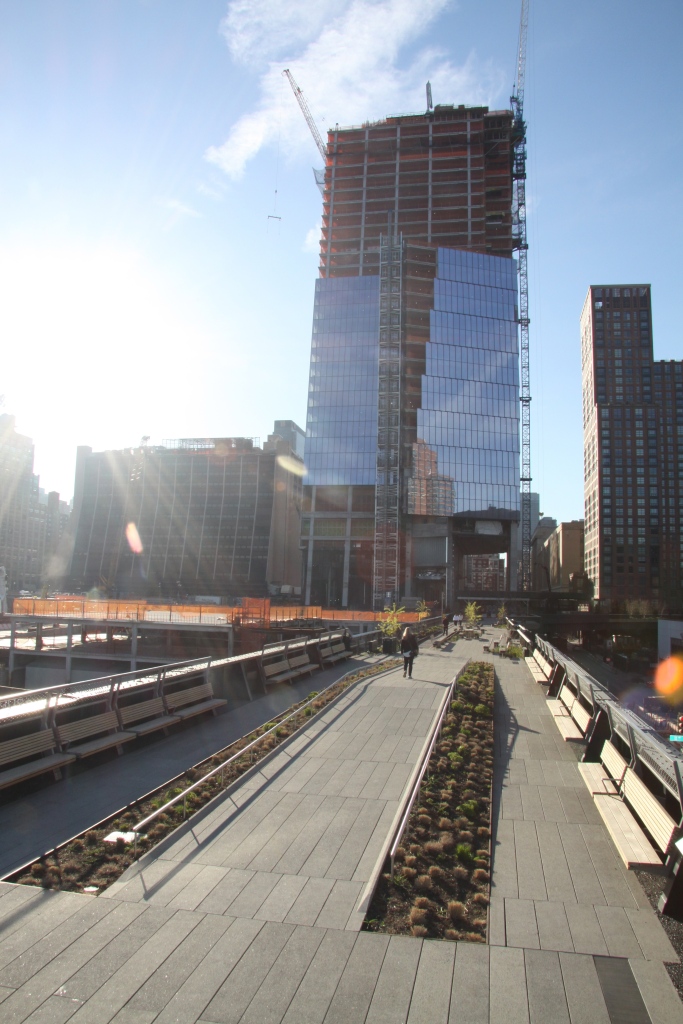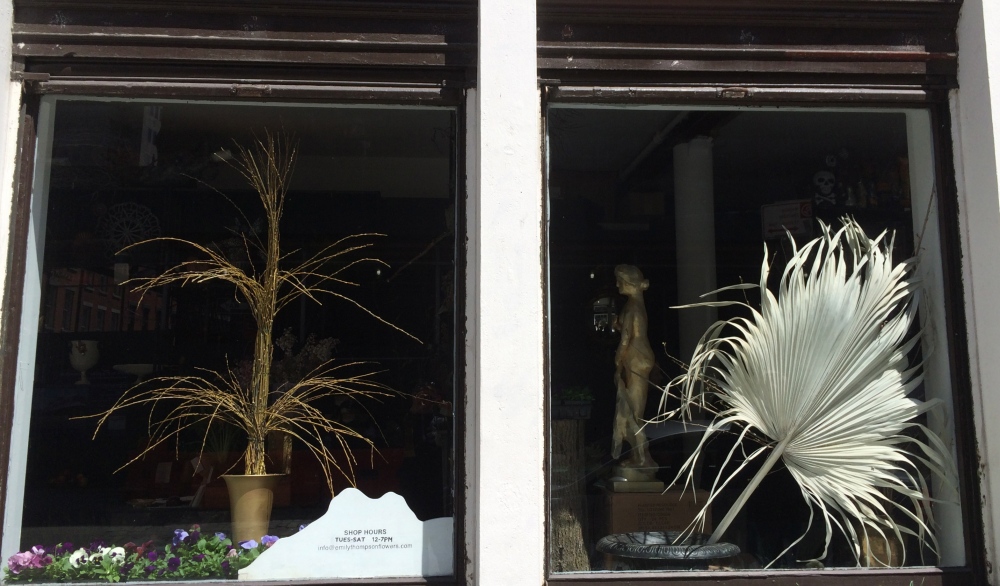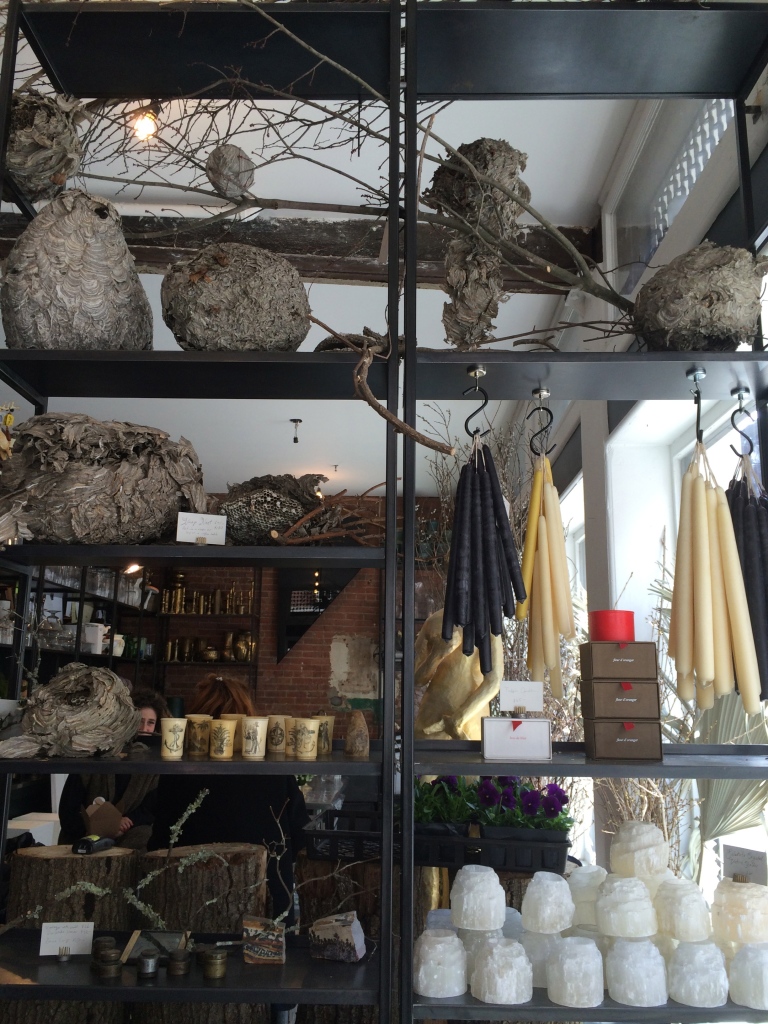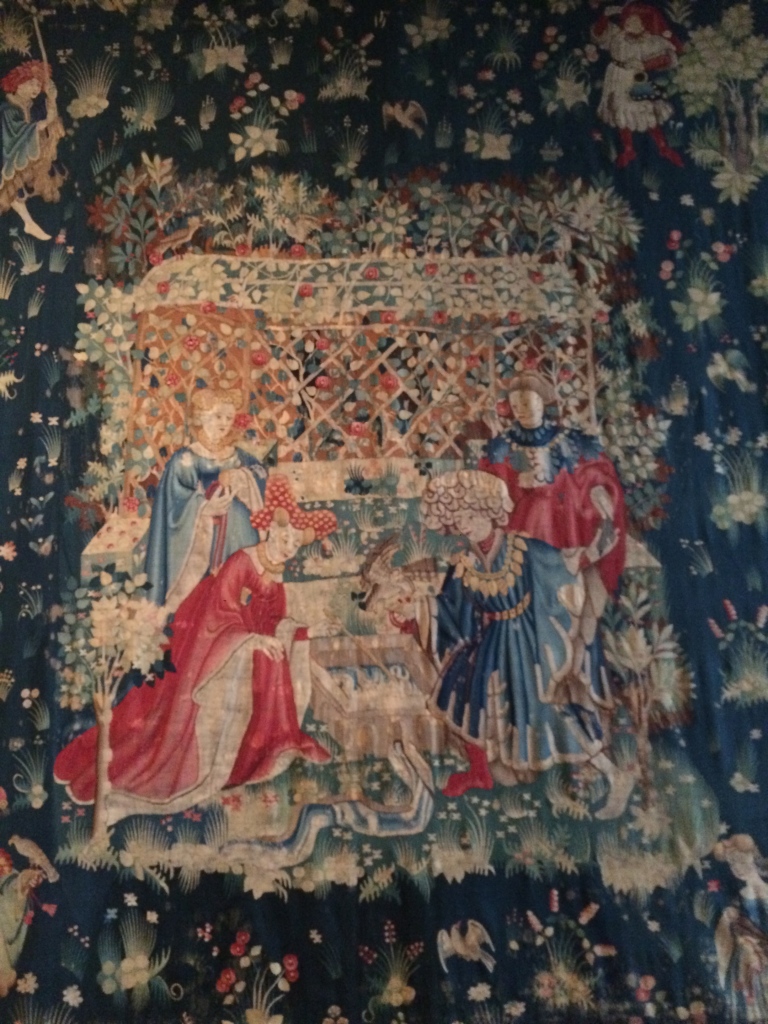A TASTE OF HONEY – FROM THE HIGH LINE TO GROUND ZERO IN ONE DAY
Andrew’s Honey – Union Street Farmers’ Market
The forecast for Saturday 25th April is cold but sunny. I am up at the 30th Street access to the High Line for its opening at 7am.
On the High Line at 7am
On the way there is the occasional tantalising glimpse of what might be to come:
Kris Martin, Altar, 2014, seen from the street
The 30th Street access brings you to the most newly planted section of this mile and a quarter stretch of public garden created from a disused section of freight railway line suspended between Chelsea and the Meatpacking District on Manhattan’s West Side
Initially, the High Line impresses as a thoughtful, well designed, technically demanding piece of landscape architecture – the leading landscape architectural practice was James Corner Field Operations
 – but the planting, masterminded by Piet Oudolf, and the dynamic, intuitive way the whole project interacts with the surrounding buildings, soon begins to take your breath away.
– but the planting, masterminded by Piet Oudolf, and the dynamic, intuitive way the whole project interacts with the surrounding buildings, soon begins to take your breath away.
At this very early point in a New York spring, it is the range and sheer quantity of the trees that I find most extraordinary. The visitor’s proximity to these trees, planted in shallow soil in exposed conditions, is exhilarating. You are right there, walking through an intimate forest:
 Approaching a young forest of silver birch
Approaching a young forest of silver birch
One minute you are catching a cheery rainbow-painted building through bud-laden branches:
A rainbow-painted building viewed through branches of a cercis tree in shadow
The next, the nearest buildings are lost behind a haze of catkins:
 Neighbouring buildings disappearing behind a haze of silver birch catkins
Neighbouring buildings disappearing behind a haze of silver birch catkins
This great proximity slows you down so that you can really look at the unfolding neat bronze leaves and white flowers of an Amelanchier:
Or try to work out the tree from which these magnificent pale yellow-green hands of leaves are unfurling:
 The leaves of either Magnolia macrophylla or Magnolia tripelta (too early for even the Friends of the High Line to be sure!) so close you can watch them unfurl before your eyes
The leaves of either Magnolia macrophylla or Magnolia tripelta (too early for even the Friends of the High Line to be sure!) so close you can watch them unfurl before your eyes
You have time to appreciate the impact of a burst of dazzling pink against great swathes of regimented brick:
Cercis canadensis at full throttle (the extensive High Line plant list numbers four varieties )
I love this almost schmaltzy coming together of pink and white blossom, sky blue and glass:

 Cercis canadensis and Amelanchier against blue sky and blue glass
Cercis canadensis and Amelanchier against blue sky and blue glass
And I enjoy the muscly, richly toned silhouettes of Rhus typhina – Stag’s Head Sumach – against the milky aqua glass and telling typography of the Giorgio Armani building.
 Rhus typhina buds against an office window
Rhus typhina buds against an office window
On the other side of the walkway, the same russety buds and outspread branches confidently frame the muddy waters of the Hudson below, and the proudly fluttering U.S. flag beyond.
 Rhus Typhina branches on the High Line framing a U.S. flag
Rhus Typhina branches on the High Line framing a U.S. flag
There is a constant intuitive awareness of the way the planting and architecture will relate. I like the simplicity and pallor of these silver birches against a chapel facade:
Silver birch against a chapel
And the way the lovely apple-blossom-coloured ornamental quince, Chaenomeles ‘Toyo-Nishiki’, is gently repeated along the walk-way to form soft mounds against which a bench looks settled or a naked barrier more clothed:

 Chaenomeles ‘Toyo-Nishigi’giving the bench a settled feel
Chaenomeles ‘Toyo-Nishigi’giving the bench a settled feel
The shadows of trees and shrubs against the walls beyond the High Line are extraordinary too:

 Shadows of trees and plants, the High Line
Shadows of trees and plants, the High Line
At other points, where there is mostly only the promise of things to come at ground level, there are simple bulb plantings which are intuitive and spot on. There is an exhilarating intensity to the yolk-yellow Narcissus ‘Hawera’ which are planted in daringly dense clumps under the shimmering new leaves of silver birch to make an impact on this high open rail road:
Dense clumps of Narcissus ‘Hawera’ lighting up the old railway track of the High Line
I look around me one last time (before descending to eat an almighty blueberry pancake breakfast, obviously) and wish myself back as soon as possible to see this wonderful strip of wooded city later in the season:
The amazingly wooded High Line, April 25, 2015
On to The Union Square Farmers Market to visit Andrew Cote who sells the honey he harvests from beehives all over the city. I have been sent here by artist Judi Harvest who took me to her wonderful Honey Bee Garden on Murano, Venice which I wrote about in my post of October 2013 .
Buckets of Pheasant’s Eye Narcissus for sale at Union Square Farmers’ Market
Andrew Cote’s honey stand at Union Square Farmers’ Market
Andrew is a passionate and pioneering beekeeper who takes care of beehives all over New York, including several sited – such as the hives on the rooftop garden of Judi Harvest’s studio – near the pollen rich High Line. He sells this delicious, locally produced honey in Farmers’ Markets in the city (the stall was teeming and we buy a bag full of honey and honeycomb) and travels the world with the organisation Bees Without Borders teaching beekeeping as a way to help alleviate poverty. Andrew tells us that there are possible problems ahead with retaining permission to hang on to these brilliantly positioned rooftop hives. If anyone can campaign successfully to keep them, I am sure it will be him.
The passionate Andrew Cote with his High Line, Brooklyn and special ‘Whipped’ honeys
In the afternoon we arrange to meet our son at Ground Zero. I don’t know quite why a visit here had not been on our original itinerary – maybe we casually believed we had a pretty good idea what to expect. We are so glad that our plans changed. We leave the 9/11 Memorial grounds moved, educated and powerfully reminded.
 One of the two ‘Reflecting Absence’ pools at Ground Zero designed by Michael Arad with landscape architect Peter Walker
One of the two ‘Reflecting Absence’ pools at Ground Zero designed by Michael Arad with landscape architect Peter Walker
The atmosphere on the site when we arrive is gentle, thoughtful, bustling – just a little light family-group-photography, but mostly people are quiet from the impact of the unbearably elegant, cavernous pools that mark the footprints of the Twin Towers. These large, open ‘voids’ are fed with relentless sheets of water which head down further into the darker, recessed pools at their centre. The memorial plaza was designed by Michael Arad in conjunction with landscape architect Peter Walker, the winning entry of an international design competition with 5201 submissions. Around the edge of each pool, grouped together to represent the floor of the building where the victims died, the names of the people who lost their lives are beautifully engraved. Almost immediately, in clear, finely chiselled script, we find the name of a close friend’s brother. He had been working in one of the towers and when he died he left behind the most loving family including a young wife and three very young children. I had not expected to be so tremendously saddened.
Looking again across the South Pool I am entranced by a stately, blossoming, almost ghostly tree amidst the sea of young swamp white oaks (Quercus bicolor) that have been selected for their toughness, durability and rich autumn colour.
Our son, Llewelyn, who had been into the impressive 9/11 Memorial Museum told us the extrordinary story of The Survivor Tree.
The tree, a Callery Pear, (Pyrus calleryana), had been discovered in the devastation at Ground Zero a few weeks after the terror attacks. It was severely damaged, with broken roots and burned and broken branches. The tree was removed from the rubble and cared for by the New York City Department of Parks and Recreation.
The Survivor Tree being nurtured back to health by the New York City Department of Parks and Recreation – photograph from the 9/11 Memorial website
It was returned to the Memorial in 2010 with new, young limbs growing from gnarled stumps.
The Survivor Tree being lowered back into position at Ground Zero – photograph from the 9/11 Memorial website
The tree has become a living reminder of resilience, survival and rebirth and is often the focus for gatherings of remembrance.
 President Obama at a service of remembrance next to The Survivor Tree – photograph from the 9/11 Memorial website
President Obama at a service of remembrance next to The Survivor Tree – photograph from the 9/11 Memorial website
I felt a little ashamed that I did not know about this remarkable tree before I came to New York. Looking back at the photographs I took during my trip, I wonder if this ethereal iPhone image of The Survivor Tree is not in fact the photograph which I will remember for the longest time:
The Survivor Tree, 9/11 Memorial
































































































